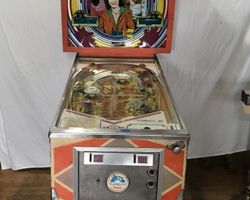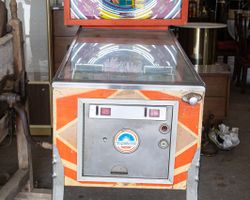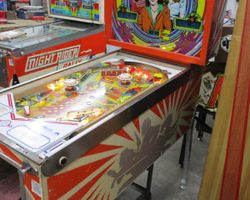Charlie's Angels

Average Prices: USD $300 to $1,100
Produced: November, 1978
Production Run: 7,600 units
Machine Type: Solid State Electronic
MPU: Gottlieb System 1
Players: 4
Design by: Allen Edwall
Art by: Gordon Morison
Charlie's Angels, a pinball machine brought to market by D. Gottlieb & Company in November 1978, stands as a notable example of the era's licensed theme machines. The game drew directly from the popular television show of the same name, capturing the likenesses of its stars, Jaclyn Smith, Kate Jackson, and Cheryl Ladd, on its artwork. This machine, identified as Model Number 425, represents Gottlieb’s forward trajectory into solid-state electronic pinball production, though it also saw a smaller production run as an electromechanical (EM) version, a testament to the industry's transitional period.
The design of Charlie's Angels was a collaborative effort, with Allen Edwall credited for the game's layout and Gordon Morison for its distinctive artwork. Morison’s art package aimed to integrate the visual appeal of the television series onto the playfield and backglass. Released with a production run of 7,600 solid-state units and 350 electromechanical units, Charlie's Angels found its way into arcades and homes as Gottlieb continued to innovate its System 1 MPU platform. Its public debut was highlighted at the AMOA show in Chicago, held from November 10-12, 1978, where a special show model featuring a cutaway cabinet and a semi-transparent backglass offered attendees a unique glimpse into the machine's inner workings.
Signature Features and Design
Charlie's Angels, as an early solid-state pinball machine, incorporates fundamental elements that defined gameplay in the late 1970s. The game features a standard two-flipper setup at the bottom of the playfield, complemented by two pop bumpers and two slingshots, all essential for ball manipulation and scoring. A manual plunger initiates each ball, characteristic of machines from this period.
Central to the machine's design are its prominent drop target banks: a five-bank and a three-bank. These targets are not merely passive elements but are core to the game’s scoring progression and strategic depth. A single standup target also provides an additional scoring opportunity. Gordon Morison's artwork on the playfield and backglass serves as the primary visual draw, depicting the three protagonists of the show. While some opinions on the artwork vary, its direct link to the licensed theme provided a recognizable and engaging aesthetic, contributing significantly to the machine's appeal. The machine’s construction, typical of Gottlieb’s output from this period, is generally regarded as robust and reliable, ensuring longevity and relative ease of maintenance for owners. The digital display provided clear score readouts, a step up from the segment displays of earlier electronic games.
Playfield and Mechanics
The playfield of Charlie's Angels is arranged around a philosophy of target shooting and bonus accumulation. At the bottom, the two flippers control the ball's trajectory, working in conjunction with the slingshots positioned above them to redirect the ball. The two pop bumpers are situated in the upper playfield, contributing to unpredictable ball movement and score accumulation.
The primary objectives on the playfield are the two sets of drop targets. On the right side, a three-bank of drop targets presents a direct challenge. A unique rule dictates that these targets reset only when a shot successfully reaches a designated lane at the top of the playfield, encouraging players to vary their shots and pursue specific objectives. A larger five-bank of drop targets is also present, providing additional scoring and game progression. These target banks, when cleared, are instrumental in building the player's bonus multiplier.
Navigating the upper playfield requires precise shots. There are rollover lanes at the top, and while hitting them contributes to scoring, some players found their overall strategic value to be limited. A notable feature, often discussed among players, is the left lane or "ramp." This element was intended to offer a return path but frequently resulted in the ball losing momentum, leading to "airballs" or directly draining down the middle, a design characteristic that became a point of contention. In contrast, the right orbit or lane is generally considered well-executed, offering a satisfying shot. The pop bumpers, while contributing to the play experience, have been noted by some as being positioned in a somewhat random or illogical manner within the playfield layout. Gordon Morison’s artwork integrates with these playfield elements, using vibrant colors and character depictions to immerse players in the television show’s world, with lighting effects typical of early solid-state machines, illuminating targets and features as play progresses.
Gameplay Dynamics
The gameplay dynamics of Charlie's Angels center on a straightforward yet engaging progression system, characteristic of early solid-state pinball machines. The primary goal is to maximize the end-of-ball bonus by hitting various targets and then strategically cashing it out. The two main drop target banks, the five-bank and the three-bank, are critical for achieving this. Successfully clearing these banks increments the bonus multiplier, urging players to repeatedly target them.
A distinguishing challenge lies with the three-bank drop targets on the right side of the playfield. Unlike many other target banks, these targets only reset when the player executes a precise shot to a specific lane at the very top of the playfield. This unique reset condition introduces a strategic layer, compelling players to consider their shot choices carefully, balancing direct target assault with the need to reset for further bonus accumulation.
Beyond the drop targets, the game rewards skilled players with challenging shot angles to the upper lanes. Mastering these shots contributes to the overall score and can be crucial for completing specific objectives that advance the bonus multiplier. The general flow of the game emphasizes consistent target shooting, making it a "shooting gallery" experience that rewards precision and repetition. While lacking complex multi-ball modes or deep narrative-driven objectives common in later machines, Charlie's Angels focuses on core pinball mechanics: consistent flipper skills, accurate target acquisition, and strategic bonus management. The game maintains a fast pace for players who master its shot angles and flow, making it a rewarding experience for those who appreciate direct, skill-based pinball.
Reception and Legacy
Charlie's Angels received a mixed, but largely positive, reception within the pinball community, with a strong undercurrent of nostalgia influencing many players' perspectives. For many, the machine conjures fond memories tied to the popular 1970s television show and the arcades of that era. A common sentiment is that the game "grows on you," often requiring repeated plays and proper calibration to fully appreciate its nuances.
Among its strengths, the gameplay is frequently cited as challenging and engaging. Players often appreciate the direct target shooting focus, which contributes to a fast-paced experience once the shots are mastered. The strategic depth of building and cashing out the bonus, along with the challenging skill shots to the top lanes, provides a rewarding experience for those who develop the necessary precision. The machine’s build quality and reliability are also well-regarded, typical of Gottlieb machines from that period, with System 1 games often noted for their relative ease of operation and maintenance. The licensed theme itself is a significant positive for fans of the television series, with many appreciating the accurate representation of the show. While some find the artwork merely acceptable, others consider it decent for its time. A notable improvement for modern owners involves upgrading the MPU board with aftermarket solutions, such as Pascal Janin's PI-1 MPU board. These upgrades can introduce features like a high score table, ball save, skill shot, and an enhanced attract mode, significantly improving the contemporary play experience.
However, Charlie's Angels is not without its criticisms. The electronic sound package is almost universally described as basic or "dreadful," often cited as a major drawback. Playfield design flaws are also a common point of discussion. The left ramp or lane, for example, is frequently criticized as a "lane to nowhere" that often results in the ball returning down the middle or becoming an airball, seen as a wasted opportunity in the layout. Some players also found the upper lanes lacked sufficient value or purpose, and the placement of the pop bumpers occasionally felt random. Additionally, some felt the game offered limited variety in targets, potentially leading to boredom over extended play sessions. The artwork, while appreciated by some, was also described by others as not exceptional, disjointed, or even featuring an "ugly backglass."
Despite these points of criticism, Charlie's Angels holds a distinct place in pinball history. It represents Gottlieb’s early foray into solid-state electronic pinball, existing alongside an electromechanical version that highlights the industry's transition. Its unique design choices, including the frequently discussed left lane, contribute to its character and provide a point of reference for discussions on pinball design. The enduring appeal of its licensed theme, combined with the robust build quality of Gottlieb’s System 1, has allowed it to remain a relevant machine for collectors and enthusiasts who appreciate the era's design philosophies. Its continued playability, often enhanced by modern technological upgrades, ensures its legacy as a machine that, while flawed in some aspects, remains a challenging and often engaging experience.
Sponsored Links
 Ebay Listings
Ebay Listings
 Auction Results
Auction Results
| Cost | Location | Date |
|---|---|---|
| USD $270 |  New Jersey, United States New Jersey, United States |
01 May, 2025 |
| USD $1,400 |  Michigan, United States Michigan, United States |
22 March, 2025 |
| USD $700 |  Wisconsin, United States Wisconsin, United States |
07 August, 2024 |
| CAD $1,300 |  Canada Canada |
11 May, 2024 |
| USD $685 |  United States United States |
25 October, 2023 |
| USD $4,000 |  Florida, United States Florida, United States |
17 February, 2023 |
| USD $240 |  Pennsylvania, United States Pennsylvania, United States |
29 January, 2023 |
| USD $1,849 |  Illinois, United States Illinois, United States |
19 October, 2022 |
| USD $575 |  New York, United States New York, United States |
14 October, 2022 |
| USD $650 |  Iowa, United States Iowa, United States |
26 July, 2022 |


Private Policy · Search Website · Contact Us
As an eBay Partner, we may earn a commission from qualifying purchases made through links on this site, at no additional cost to you.
All trademarks and copyrighted materials remain property of their respective owners. All other content copyright 2007 - 2025 Pinpedia.







